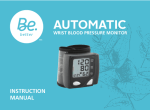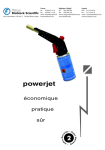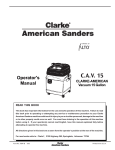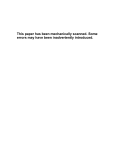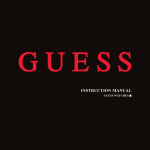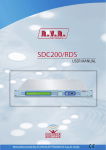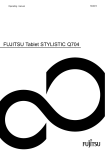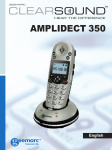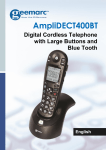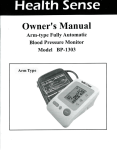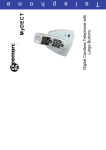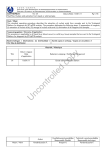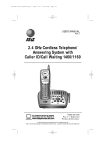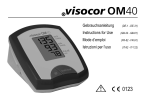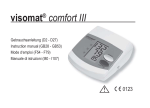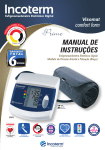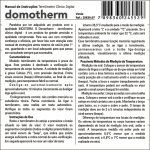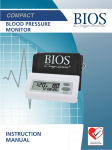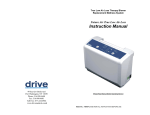Download Visomat Handy User Manual available in PDF format
Transcript
® visomat handy CL Instructions for Use (GB30 - GB57) D Contents A Product information/notes on use Device description/indicators 34 32 B Abridged instructions on measurement 36 C Operation of the device 1. Setting up the device 38 2. Fitting the cuff 38 3. Positioning the device correctly 39 4. Inflating the cuff 41 5. Measuring blood pressure 42 6. Irregular pulse waves 43 7 Memory recall 44 8. Delating the memory 44 D Important information 1. Basic rules for blood pressure measurement 2. Other points to note 45 • Wrist circumference 45 • Cardiac arrhythmia 45 • Frequency of cardiac pacemakers 46 • Pregnancy 46 • Medicines 46 • Intravenous supply systems 46 • Unusual results 46 45 E What you should know about blood pressure 1. Systolic and diastolic blood pressures 47 2. Why you have to measure different parameters 47 3. Why measure regularly?47 4. What are normal blood pressure levels? 48 F Maintenance 1. Changing the batteries 48 2. Cleaning and disinfection 3. Customer service 49 G 49 Appendix 1. What to do in the event of measuring errors and operating errors 50 2. Specifications/accessories/spareparts 52 3. Explanation of symbols 54 4. Metrological inspection 55 5. Warranty 56 Product information / Notes on use A Product information These instructions are designed to help the user operate the digital visomat® handy CL blood pressure monitor safely and efficiently. The monitor must be used according to the procedures contained in these instructions and for no other purpose. Read through the instructions carefully and familiarise yourself particularly with the section entitled «Basic rules for blood pressure measurement». Notes on use The visomat® handy CL is a digital automatic monitor for measuring blood pressure at the wrist. It is based on the non-invasive analysis of the systolic and diastolic blood pressures at the arm and the measurement of adults’ pulse rates, i.e. those of people 15 years of age and over. If the monitor is used on younger patients, the readings should be compared with doctors’ measurements. Please call our Service phone line for more information. Do not under any circumstances use the monitor on babies/infants. The product is recommended to patients with unstable blood pressure or known hypertension, for home use and therapy support. There may be a flaw in the accuracy of the measurement if absolute quiet is not observed while the measurement is being taken or the conditions stated are outside those parameters laid down in the specifications. See technical data. The cuff fits at a wrist circumference of 12,5 to 21,5 centimetres. The device covers pressures up to 300 mmHg and a pulse rate of 40 to 160 beats per minute. Method of measurement This product uses the oscillometric method for measuring blood pressure and pulse rate. The cover is placed round the arm as shown on the diagram on the cuff. When the Start/Stop button is pressed, the device starts to build up pressure automatically. Within a very short space of time the device records the small oscillations within the cuff, which occur owing to expansion and contraction of the arteries in the arm (pulsation). The automatic pressure build-up usually stops at approx. 190mmHg. If the cuff pressure is too low, the device automatically increases the pressure in increments of 40mmHg. During the deflation, the cuff detects pulse waves, which are transfused to the pressure transducer in the device chassis. Out of the amplitude of each pressure wave the values of Systole and Diastole will be calculated and displayed. From the temporally space between the pulse waves, the pulse frequency will be calculated and displayed.The monitor offers an additional display for identifying irregular pulses. This can be an indication of an irregular heartbeat (arrhythmia) but also of unrest during the measurement (Irregular pulse waves). A memory stores the last 30 results for the purposes of comparison. Device description A Device description 1 2 3 4 5 Display for systole, diastole, pulse and control readings Start/Stop button Memory button (memory recall button) Battery compartment Cuff Check display / symbols No.30 Memory data (No. Of measurement) A 13 Average No. of stored data Device measuring Irregular pulse waves Battery exchange SYS DIA PUL Systole Diastole Pulse rate Inflation / Deflation Abridged instructions on measurement Please read the detailed Instructions for Use before measuring for the first time (from page 38 onwards). 1. Insert batteries (Alcaline batteries LR6) 2. Fit the cuff Bare your left wrist, remove any watch or jewellery. Place the device round the wrist. The distance between the top edge of the cuff and the palm should be approx. 1 cm (Fig. 1). Close the cuff. Keep the device at heart level (Fig. 2). Keep your arm still and do not talk. Abridged instructions on measurement eng 3. Inflate the cuff Press the Start/Stop button. The device conducts a performance test and all the display elements light up. Inflation of the cuff is automatic up to approx. 190 mmHg. If cuff pressure is too low, the device automatically increases the pressure in increments of approx. 40 mmHg. 4. Blood pressure measurement After inflation the air is let out automatically, the falling cuff pressure is displayed and the „? “ symbol flashes and a beep sounds. Automatic deflation of the cuff indicates the end of measurement. The systolic and diastolic blood pressure readings will appear in the display together with your pulse rate 5. Switch off the device Press Start/Stop button. The figures measured are saved automatically. Operation of the device C 1. Setting up the device Place the enclosed batteries in the device if they have not already been inserted (see page 48, Changing batteries). 2. Fitting the cuff Bare your left wrist, remove any watch or jewellery. Place the device round the wrist. The distance between the top edge of the cuff and the palm should be approx. 1 cm. Left-handed persons can place the cuff round their right arm. The instructions for use apply by analogy. Now pull the free end of the cuff tight and place it over the velcro strip firmly. Owing to its optimised shape the cuff sits tightly in order to prevent any measuring errors. Impor tant: Never u se t he de vi ce abov e a critic al p art of the bod y (e.g. wound , intr avascul ar po rt etc.). 3. Positioning the device correctly 3 measuring positions are possible: 1. Place the left arm on a dining table and place it at an angle in such a way that the wrist is exactly at heart level. For that you could support your arm with a cushion for example, but avoid a bend of the wrist. 2. If measurement is not being performed at a table, the following position can be used: press the Start/Stop button and place the left arm loosely against the body in such a way that the cuff of the device is at heart level. To assist and relieve the left arm you can use the right arm as a support. Keep both arms still until measurement has been completed. 3. Measuring in the lying position Lie down on your back. Place the device round your wrist and keep it at heart level, supported by a cushion for example. To relax before measurement, take a deep breath 5 or 6 times. During measurement it is important to keep your arm still and refrain from talking. If the cuff is lower or higher than heart level, the measured value will tend to be higher or lower as the case may be. Important: Never use the device above acritical part of the body (e.g. wound, intravascular port etc.). Corr ect m easu rem en ts can onl y b e obt ained if th e cuff is at he art lev el. If th e w ri st i s too hig h or too low, it w ill lead to false result s. Operation of the device 4. Inflating the cuff Switch on the device by pressing the Start/Stop button. The entire display lights up (segment test). In this way you can check to make sure that all the display elements are working properly (Fig. 1). The automatically controlled inflation process (Fig. 2) starts after the monitor has calibrated itself against the ambient air pressure and stops at approx. 190 mmHg. If that cuff pressure is not sufficient for measuring blood pressure levels, the device automatically increases cuff pressure in increments of approx. 40 mmHg until sufficient pressure has been reached. The inflation and measuring process can be discontinued at any time by pressing the Start/Stop button. To control the inflation processed manually, keep the Start/Stop button pressed as soon as inflation has started and release it again as soon as cuff pressure has reached 40 mmHg above the maximum systolic pressure to be expected. If cuff pressure has exceeded approx. 190 mmHg, inflation stops as soon as you let go of the button. The pressure can be increased up to approx. 280 mmHg. Pleasenote: The device may only be inflated when it is attached tothe wrist. Operation of the device 5. Measuring blood pressure As soon as the necessary cuff pressure has been reached, the pump switches off and the air is let out automatically. The falling cuff pressure appears on the display. After a short while the „?“ symbol flashes and a beep sounds at the same rate as your pulse. At the end of measurement air is let out of the cuff automatically. The blood pressure levels measured and the pulse reading appear on the display. The systole, diastole and pulse levels are saved automatically when the device is switched off. 6. Irregular pulse waves If the irregular pulse wave symbol flashes after a measurement, the monitor has registered an irregular pulse during the measurement. This can be set off by an irregular heartbeat (arr hythmia), disturbances caused by movement, talking or even breathing in deeply. Essentially, it involves the detection of an event which can unfavourably influence the measurement results. Measurement results accompanied by flashing heart symbol displays should therefore be viewed as critical and repeated under more favourable conditions. onstant repetition of measurements can bring about congestion and thus lead to incorrect results. Const ant r epeti tion o f m easur ements c an brin g abou t con g estio n an d thus le ad to in cor rect result s. Betw een measu rem ent s t ake a b reak of at l east 3-5 min u tes. Between measurements Operation of the device 7. take a break of at least 3-5 minutes. Memory recall The device has a memory which makes it possible to display the last 30 blood pressure levels and pulse values measured and to indicate the mean (average). If you press the Memory button, the mean value will appear provided 2 measurements have already been saved. The mean is indicated by „A“ and the number of results saved. Pressing again calls up the last value measured. Pressing again displays the previous measurement as the case may be. In this way you can call up all 30 measurements backwards. If more than 30 measurements have been saved, the oldest measurement (no. 30) is deleted in order to record the latest measurement (no. 1). If the button is pressed again, the mean of all the measurements appears. Reco rd t he fi gu res s aved in your blood p ressu re p ass. Over a l en gth y p erio d thi s will provide you w ith a b ett er pictur e of you r blo o d p res sur e situ ation , whi ch you m ay wish to d i scuss with your do cto r. 8. Deleting the memory To delete individual measurements, press the Memory button a number of times to call up the measurement required, press again and keep the button pressed for 8 - 10 seconds . The figures will flash 4times, then the measurement is disappeared. To delete the entire memory, call up the mean, press the Memory button again and keep it pressed until the mean has disappeared (8-10 sec) Record the figures savedin your blood pressure pass.Overa lengthy period this will provide you with a better picture of your blood pressuresituation, which you maywish to discuss with your doctor. 1. Basic rulesfor blood pressuremeasurement • Measurement must be performed when you are at rest. Blood pressure is increased by walking and climbing stairs. Wait at least 5-10 minutes until your circulation has calmed down. • Check your blood pressure twice a day – in the morning after getting up, and in the evening when you have relaxed after work. • Blood pressure should be measured when you are seated. For measurement, sit down at your dining table (never at a low coffee table) in as relaxed and upright a posture as possible, support the arm and back, and do not cross your legs. Keep your wrist at heart level. Do not bend your wrist. • The most reliable way of obtaining accurate measurements is to take off your watch or jewellery and perform measurement on your bare wrist. • During measurement the arm with the cuff must remain still in order to prevent interfering pulses. measurement. Do not talk during • Between successive measurements always take a break of about 3-5 minutes in order to prevent incorrect measurements. 2. Other points tonote • Wrist circumference The cuff is designed for a wrist circumference of 12,5 – 21,5 cm. • Cardiac arrhythmia / Irregular pulse waves If you suffer from cardiac arrhythmia. Therefore consult your doctor before measuring your blood pressure. The monitor is also equipped with a pulse unrest detection facility. This indicates to users the irregular pulse waves signals during a measurement. These can be caused by an irregular heartbeat or unrest and disruptive movements during the measurement. In each case, clarify all possible instances of an irregular heartbeat with your doctor. • Frequency of cardiac pacemakers The display of pulse rate is not suitable for monitoring the frequency of cardiac pacemakers. • Pregnancy Blood pressure levels can be different as a result of pregnancy. Only perform blood pressure self-monitoring after consulting your doctor. • Medicines Never use this device without consulting your doctor first if you are undergoing dialysis treatment or taking anti-coagulant, anti-platelet medicines or steroids. The use of a blood pressure monitor under such conditions can cause internal bleeding (possibly causing haematomas). • Intravenous supply systems Medical supply systems (e.g. infusions) may temporarily discontinue supply if the cuff is constricted. • Unusual results Any measurement is largely dependent on the circumstances during the measuring procedure. Before measurement people often fail to take time to calm their circulation adequately, use incorrect cuff sizes, they talk or move about during measurement. See also the table of measuring errors and operating errors on page 50. Check the situation yourself if necessary. Have you met all the conditions? Take time for measurement – you are monitoring your health! Self-measu rem en t do es not cons tit ut e tr eatm ent. Never ch ang e o f your o w n acco rd the d o se o f medi cin es pr escri b ed by you r d octor. What you should know about blood pressure E 1. Systolic and diastolic blood pressures The cardiovascular system has the important function of supplying all the organs and tissues in the body with sufficient blood and removing metabolic products. The heart contracts and relaxes at a regular rate of about 60-80 times a minute. The pressure of the flowing blood on the arterial walls, which arises when the heart contracts, is termed systolic. The pressure in the ensuing relaxation phase when the heart is refilled with blood is termed diastolic. When you perform daily monitoring you measure both figures. 2. Why you have to measure different parameters Our blood pressure responds to external and internal influences like a sensitive measuring instrument. It can be affected by even slight changes. That makes it easier to understand why figures measured at the doctor‘s or pharmacist‘s are often higher than those you measure at home in your accustomed environment. Changes in weather, changes in climate, physical work and emotional stress can also have an effect. 3. Why measure blood pressureregularly? The time of day also has an influence on the level of blood pressure. During the day the figures are usually higher than during periods of rest at night. For this reason, one-off measurements and irregular measurements will tell you little about your actual blood pressure. Reliable assessment is only possible if individual measurements are taken regularly. Discuss the results with your doctor. 4. What arenormal bloodpressurelevels The World Health Organization (WHO) has compiled the following overview for assessing blood pressure levels: Maintenance Normal pressure Threshold High pressure Systolic pressure = 119 Systolic pressure 120–139 Systolic pressure = 140* and/or ** Diastolic pressure = 79 Diastolic pressure 80–89 * ** mmHg = millimetres of hydrargyrum (mercury) It is sufficient if one of the figures is too high 1. Changing batteries Diastolic pressure = 90 • Open the battery compartment Remove the cover of the battery compartment on the side of the device. • Insert batteries Take the old batteries out of the device and insert the new ones. Make sure the polarity is correct (there is a mark inside the battery compartment). The easiest way of inserting the batteries is to push them into the battery compartment while pressing their negative flat (–) terminal against the spring. • Close the battery compartment Close the battery compartment by replacing the cover. • Please note: Change the batteries - if the battery symbol on the display appears after the display segments have been tested - if the display fails to light up despite your having pressed the Start button. Always change both batteries. Only use branded batteries of the quality specified (see Specifications). If the device is going to be out of use for any lengthy period, please remove the batteries. This prevents leakage. Any battery can leak. Cautio n ! Do no t u se r ech arg eabl e batte ries. Batteries and appliances should not be disposed of with domestic waste but should be handed in at appropriate collection and disposal points. 2. Cleaning and disinfection Only clean the device with a soft, slightly moistened cloth and a small amount of detergent. Stains on the cuff can be removed carefully using a moist cloth and soap and water. If you have to disinfect the device, we recommend using Descosept AF, Dr. Schumacher GmbH, Melsungen. It can be used for fast wipe-down and spray disinfection. The cuff m u st not be wa sh ed o r dr y-cleaned. 3. Customerservice The device may only be repaired by the manufacturer or an authorised service centre. Please contact: UEBE Medical GmbH Zum Ottersberg 9 97877 Wertheim, Germany Tel.-Nr.: Fax-Nr.: E-mail: Internet: +49 (0) 9342/924040 +49 (0) 9342/924080 [email protected] www.uebe.com What to do in the event of measuring errors or operating errors People suffering from cardiac arrhythmia, vascular constrictions, arteriosclerosis in the extremities and diabetics should consult their doctor before performing blood pressure self-monitoring because in such cases the blood pressure levels may be different. Maintenance Appendix Error ERR 1:Measuring error ERR 2:Inflation error ERR 3:Deflation error ERR 300 Error No readings in the display fields. Battery symbol appears after segment test Incorrect measured values Measurements too high Cuff is not being inflated Cause Arm or body movement during measurement. The cuff is not sitting properly. Talking during measurement. No pressure is being built up in the system. Deflation rate too high or too low. Remedy Repeat measurement after 3-5 minutes. Do not move your arm and do not talk. If the error occurs again, contact customer service. A fault has been detected. Repeat measurement after 3-5 minutes. Do not move your arm and do not talk. Repeat measurement after 3-5 minutes. Check batteries Remedy Repeat measurement after 3-5 minutes rest. Possible factors (depending on the severity of the arrhythmia) affecting the measurement results should be discussed with your doctor. Check batteries and replace if necessary. Inflation pressure above 300 mmHg Battery error Cause Irregular heartbeat, disruptive movements, shaking, wobbling (objects), breathing in deeply, etc. No batteries inserted. Batteries not inserted properly. Batteries empty. Batteries empty. Arm or body movement during measurement. Wrist position too high or too low. Cuff not sitting properly Cuff not fitted properly Cardiac arrhythmia during measurement Was the necessary rest observed before measurement? Batteries empty? Repeat measurement and if the error occurs again, call the service telephone number. If the error occurs again, call the service telephone number. Check batteries and replace if necessary. Repeat measurement after 3-5 minutes. Do not move your arm and do not talk. Repeat measurement after 3-5 minutes, with your wrist at heart level. Check wrist circumference (12,5 - 21,5 cm). Repeat measurement after 5 minutes Repeat measurement after 5 minutes Repeat measurement with at least 5 minutes‘ relaxation before the next measurement Check batteries and replace if necessary. Appendix 2. • • Specifications/accessories/spare parts Type ofdevice: ®visomat handy CL – automatic digital device with electric pump for blood pressure monitoring on the wrist. Serial number: In the batterie compartment is a serial number, • • • • • • • • • • • which provides clear identification of the device. Device dimensions: ca. B = 65 mm x L =66 mm x H = 31 mm Weight:110 g not including batteries Measuring system: Oscillometric determination of systole, Referenceprocedure of clinical trial: Auscultatory measurement Display: LCD display (liquid crystal display) Memory: 30 measurements (saved automatically) and Pressuredisplay range: 0-300 mmHg Measuring range: Systolic: 50 – 250 mmHg Diastolic: 40 – 180 mmHg Pulse measurement: 40 – 160 beats/min Limits of error of pressuredisplay: Blood pressure monitoring: conforms to EN 1060 Part 3 Pressure measurement: ± 3 mmHg Pulse measurement: ± 5 Cuff: Doubled preformed cuff, Type H4 Deflation valve: electronic control valve diastole and pulse average value • Inflation pressure: approx. 190 mmHg Additional inflation in increments of 40 mmHg • Deflation rate: On average 5,5 mmHg/sec • Batteries: – battery type: 2 x 1.5 V Micro/AAA LR 03 cells – Service life: More than 600 measurements in 2 years – Battery indicator:„ “ symbol means change the batteries – automatic shutdown: approx. 3 minutes after the end of measurement • Operating conditions Ambient temperature 10-40°C Rel. humidity up to 85% • Storage and transport conditions: Ambient temperature -5 to +50°C Rel. humidity up to 85% Subject to technical change without notice. Accessories/Spare parts You can obtain the following genuine spare parts and accessories from specialist dealers: • Preformed cuff “Type H4” (for arm circumference 12,5 – 21,5 cm) Art. no. 2104501 Impor tant: To p revent in corr ect measurements, th e devi ce may only b e u sed w ith gen uine typ e H4 cuff s. Appendix 3. Explanation of symbols This blood pressure monitor conforms to Council Directive 93/42/EEC of 14 June 1993 on Medical Devices and bears the mark CE 0123 (TÜV SÜD Product Service). Devices with CE marks are quality-controlled in accordance with this Directive and provide a high level. Degree of protection against electric shock: Type BF Observe Instructions for Use Batteries and appliances must not be disposed of with domestic waste but should be handed in at the appropriate collection and disposal points. The requirements of the following standards are met: • EN 1060-1: 1995 Non-invasive sphygmomanometers: General Requirements • EN 1060-3:1997 + A1:2005 Non-invasive sphygmomanometers: Additional Requirements on electro-mechanical blood-pressure measuring devices • EN 1060-4: 2004 Non-invasive sphygmomanometers Test procedure for establishing accuracy • IEC 601-1:1998 + A1: 1991 + 1. Medical electrical devices 2. General commitment to safety A2: 1995 • IEC 60601-1-2:2001 + A1:2004 Medical electric devices: Electromagnetic compatibility • This product conforms to Council Directive 93/42/EEC of 14 June 1993 on Medical Devices. Manufacturer: UEBE Medical GmbH Zum Ottersberg 9 97877 Wertheim Germany 4. Metrological inspection (previously calibration) Generally, a metrological inspection is to be recommended at intervals of 2 years. Professional users in Germany, however, are under obligation in accordance with the „Medical Devices Operator Ordinance“. The inspection can be performed either by UEBE Medcial GmbH, an authority responsible for metrology or authorised maintenance service centres. Competent authorities and authorised maintenance service centres can obtain a „Test Procedure for Metrological Inspections“ from the manufacturer on request. Thereto please note your national guidelines. Appendix Important: No changes maybemade to this device withoutthe manufacturer‘s permission, e.g. the device must not be opened (except tochange the batterie 5. Warranty The device was manufactured and tested with the utmost care. If it should nevertheless have defects, we give a warranty on the following terms: 1. During the term of the warranty of 3 years as of the date of purchase we agree to remedy such defects, at our discretion and at our expense, by repair (after the product has been returned to our factory) or in the form of a replacement by a non-defective device. 2. The warranty does not cover normal use of wearing parts or any damage which arises as a result of nonobservance of the Instructions for Use, improper handling (e.g. unsuitable power sources, breakage, leaking batteries) and/or dismantling of the device by the purchaser. In addition, the warranty does not cover compensation claims filed with us. 3. Warranty claims can only be filed during the term of the warranty by presenting the receipt. In the event of a warranty claim the device must be returned to the following address, together with the receipt and description of complaint: UEBE Medical GmbH, Service-Center, Zum Schlag 18, 97877 Wertheim, Germany. 4. The purchaser‘s contractual defect rights vis-a-vis the seller in accordance with § 437 of the German Civil Code are not restricted by the warranty. Important: In the event of awarranty claim please always include the receipt. Important: In the event ofa warranty claim please always include the receipt. Appendix G UEBE REF 21045 visomat und UEBE sind international geschützte Warenzeichen der UEBE Medical GmbH Zum Ottersberg 9 97877 Wertheim Germany Phone: + 49 93 42 / 92 40 40 Fax: + 49 93 42 / 92 40 80 E-Mail: [email protected] Internet: www.uebe.com Technische Änderungen vorbehalten. © Copyright UEBE Medical GmbH













